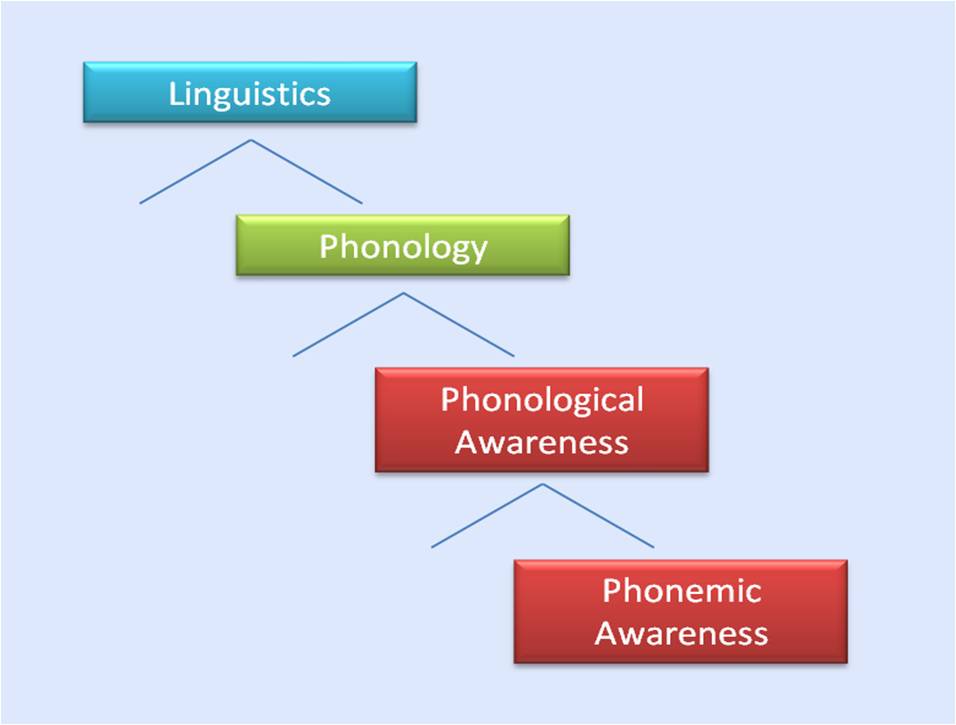Phonemic Awareness
Quick Facts about Phonemic Awareness
- Defined as the ability to distinguish and manipulate phonemes, the smallest units of speech sound that can carry a meaning
- A critical skill that all readers must develop
- Students should be assessed early (kindergarten) for the ability
- Must be taught explicitly to dyslexics, though this is not required for more efficient readers
- Is taught through activities in sound identification, sound substitution, rhyming, word blending and word segmentation
- Often falsely equated with skills in phonics
- The 'phonological deficit hypothesis' is considered the dominant explanation for dyslexia and directly implicates awareness of phonemes
Definitions
Phonemic awareness is the ability to distinguish and manipulate phonemes, the smallest units of speech sound that can carry a meaning. In English there are 44 of these sounds. The awareness can be demonstrated in the ability to isolate, blend and otherwise manipulate the essential sounds of language—for example by recognizing a set of words all beginning with the /h/ sound or isolating a sound at the beginning, middle or end of word. It does not require spelling or even the use of letters.
 Phonemic awareness as part of the field of linguistics Phonemic awareness as part of the field of linguistics |
Linguistics: the scientific study of language and its structure. |
"Phonological awareness is the ability to listen inside a word"
-Dyslexia researcher and author Jo Fitzpatrick
But isn't it just phonics?
No, phonics is about the relationship between letters and sounds whereas phonemic awareness is strictly about sounds, does not require a student to know the alphabet, or even be able to identify a single letter.
For example asking a child which word results from taking the /m/ sound off the end of the word 'farm' would be a test of their phonemic awareness. Asking him or her to sound out the word by looking at the letters would be a test of phonics.
Why phonemic awareness matters:
The phonological deficit hypothesis
According to Julian Elliott and Elena Grigorenko in their 2014 book The Dyslexia Debate, the phonological deficit hypothesis has been the dominant cognitive explanation of dyslexia for over four decades. According to this hypothesis, "children with dyslexia are hindered by faulty representation of speech sounds, which leads to problems involving the precise processing of spoken words." (Chapter two, Explanations at the cognitive level.)
Assessing and improving the cognitive processing of spoken words should be an objective of every preschool, kindergarten and early grade school reading programs because phonemic awareness is a prerequisite to a suite of critical skills including letter sound decoding (phonics), rapid word identification (use of sight words) and fluency. Piles of academic research has found that explicitly teaching students the sounds of language is a potent instructional technique:
- In a 2012 study of the relationship between phonemic awareness, rhyme awareness, short-term memory and children's reading skills, Melby and Lervag et al. found the phonemic awareness was the strongest predictor. The authors wrote of the "pivotal role of phonemic awareness as predictor of individual differences in reading development."
- In 2000, the U.S National Reading Panel found that "teaching children to manipulate
phonemes in words was highly effective under a variety of teaching
conditions with a variety of learners across a range of grade and age
levels and that teaching phonemic awareness (PA) to children significantly
improves their reading more than instruction that lacks any attention to
PA."
- G.R. Lyon found that "the best predictor of reading difficulty in kindergarten or first grade
is the inability to segment words and syllables into constituent sound
units" (Lyon, 1995, Toward a Definition of Dyslexia. Annals
of Dyslexia, 45, 3-27.)
- Renowned professor of the psychology of reading, Keith Stanovich has found that phonemic awareness is the most powerful predictor of success in learning to read, more highly related to reading than tests of general intelligence, reading readiness, and listening comprehension. (Stanovich, 1986, 1994)
In contrast, alternative approaches to teaching reading emphasize context, vocabulary and meaning, sometimes referred to as the whole language approach, now widely believed to be inferior to explicit phonemic and phonic instruction.
Skills
Vocabulary: Rhyme vs Rime
Rime: Derived from the Germanic rim, it means a sequence or series. More specifically it refers to a part of a word with a particular spelling pattern, beginning with a vowel sound and ending before the next vowel sound in the word. For example in the words hog, dog and fog the letters 'og' are the rimes. The initial letters of the word (h, d, f) are known as the 'onset'.
Rhyme: A correspondence of sounds between words. If two words contain similar sounds, usually at the beginning or end, then we say that they Rhyme. For example the words core, door and four all rhyme but do not contain the same rime.
In summary, words that rhyme don't always have the same rime. Got it?
Below are the specific skills that someone with phonemic awareness
should be able to demonstrate. Skills are listed below by the
approximate age they usually appear.
Word awareness (ages 2+)
Children
have to become aware that speech is made up of discrete knowable words,
mentally parsing them where one ends and the next begins. This occurs
naturally but it is a surprisingly difficult learning task, one a
toddler will not even recall mastering. Those studying a second language
readily understand just how spoken words can stick together. Progress
is when a garble of formerly mysterious sound is magically deciphered
into a series of meaningful words. We just get used to the magic.
Rhyme and alliteration awareness (Ages 3+)
Awareness of rhyme may be revealed though their enjoyment of rhyming verses read to them from storybooks, playful use of rhymes in songs, or from being able to actually identify rhymes in speech or even text.
Syllable awareness (Ages 3-4)
Syllable awareness is an understanding that words are composed of smaller sound chunks. Children can demonstrate knowledge of syllables by clapping out words such as hip-o-pot-a-mus. If they clap the right number of times, they are aware of syllables. Syllables are not phonemes, but awareness of them indicates a knowledge that words are composed of discrete sounds which can later be isolated and manipulated.
Rhyme Generation (Ages 3-4)
Building on their abilities to identify rhymes and syllables allows young readers to demonstrate rhyme generation involving manipulation of both the onset and rime. (See side box for definitions).
Identifying phonemes (Ages 5+)
If a child can identify the first sound in the word cat or the last sound in the word dog or identify a common phoneme in a group of words like bit, sat and wet, then they have demonstrated this skill.
Blending and segmenting phonemes (Ages 5-6)
Blending is the ability to assemble a word from its onset and rime (/b/ + /ug/ = bug) or from its phonemes, such as the sounds /c/ /a/ /p/ blending to form the word cap. Segmenting is simply reversing the process by asking students to break the words 'bug' or 'cap' down into their syllables and sounds.
Isolating phonemes (Ages 5-7)
This skill involves isolating where in a word a specific sound resides. For example, in the word 'bug' where is the /g/ sound located—at the beginning, middle or end? The most difficulty and last kind of isolation to be learned is identifying phonemes in the middle of words. Remember that this exercise is done orally, not using letters on paper and is harder for young children than it sounds.
Deleting phonemes (Ages 6-7)
If we remove the last sound from the word 'cart', what word are we left with? If a child understands that the word 'car' is left over then they can delete phonemes.
Substituting phonemes (Ages 6-7)
This skill involves being able to replace one sound in a word with another and recognizing the new meaning. For example, if we replace the /m/ sound in the word stem with the /p/ sound, what new word do we have?
Assessment
How can you tell when a child is struggling with phonemic awareness? There are some very simple, informal methods that parents and teachers can use as well as formal diagnostic tests administered by professionals.
Informal
Read out loud: For children in kindergarten or the first grade, the easiest way to reveal problems with phoneme awareness is by having them read of a list of words out loud. Ideally the list should be made up of age appropriate words which have not previously been practiced, free of context clues and pictures. If their reading is slow and errors are frequent, it may indicate a phoneme awareness problem. It is harder for parents of an only child to know what constitutes 'slow' but parents with more than one child and all teachers quickly learn how typical students read.
Importantly, the errors made won't be random. Those with weak phonemic awareness skills will guess at words based on shape and similarity of letters, because they cannot sound it out. There will be letter (b for d) and word (saw for was) reversals, but more common will be odd guesses such as reading lunch for bunch, except for expect.
Rhyming games: Ask the child to identify or create rhymes—tasks which can be done orally. Asked to generate words that rhyme with truck, a child with dyslexia may reply car and bus rather than duck or luck. The inability to complete this seemingly easy task is a very reliable indicator of dyslexia.
Formal
There are several diagnostic tests for awareness of phonemes. Dynamic Indicators of Basis Early Literacy Skills (DIBELS), Comprehensive Test of Phonological Processing (CTOPP-2), Test of Phonemic Awareness (TOPA), the Yopp Singer Test of Phoneme Segmentation, Aimsweb Test of Early Literacy and others. For more information see our dyslexia testing page.
These test should be administered by a qualified psychologist or assessor trained to administer them.
Teaching strategies & helpful resources
Better reading programs explicitly teach phonemic awareness. How do they do it? By employing creative, fun, auditory and often visual exercises which help develop each of the skills above. Below are two helpful resources.
1) Essential Strategies for Teaching Phonemic Awareness from the book 50 Reading Strategies for K-8 Learners from Sage Publications. A helpful book for teachers of kindergarten and elementary students.
2) The Reading Rockets website features helpful ideas for classroom activities.
Final Sounds
Every teacher of beginning readers should be aware of the importance of phonemic awareness, have their students assessed for it and be able to provide interventions for those students lagging in development. By fostering this ability during the critical window of early language development, teachers can make a lifelong difference for their students.
Back to the top of Phonemic Awareness

New! Comments
Share your thoughts or ideas! Leave us a comment in the box below. You can post it at this site only or on Facebook too, it's up to you.